From Archdeacon John Clarke’s blog:
Yes flowers! Last October, all the members of the congregation, as well as several of our nation’s Anglican Bishops, were invited to plant tulip bulbs in the front garden to celebrate our 250th Anniversary! Several other areas of the property were planted too.
Soon, and I hope really soon, these tulip bulbs will break through the ground and show a colourful accent all around our property.
It’s officially called the “World Friendship Tulip” and is an international symbol of peace & friendship. Seems like a fitting flower to have blooming in this our 250th anniversary year.
As the churchyard is essentially our front yard, I’m looking forward to this.
Via Patrick Rhone, a pointer to The ultimate guide to DuckDuckGo from Brett Terpstra.
I’ve been slowing replacing Google’s search with DuckDuckGo’s search on my desktop and mobile over the last year, and the transition is almost complete: even setting aside its significant privacy-enhancing features, DuckDuckGo, after years of forcing me to compromise with weaker search results, is now almost always more helpful than Google, in part because Google’s search is increasingly focused exclusively on helping me buy things.
Special bonus: search this blog in DuckDuckGo by prefixing your query with !ruk, like this:
When I was a summer camp leader at the YMCA in the 1980s, Duck Duck Goose, the children’s game, was a go-to staple for the mid-afternoon activity. I still have “duck… duck… duck… duck… goose!” burned into my brain from those days, and feel a little nervous at the anticipation of it all every time I use the search engine.
My introduction to my friend Harold Stephens came through his book Who Needs a Road?
Published in 1967, the book details his trip around the world in a Toyota Land Cruiser.
Because of geographic and geopolitical conditions in the mid-1960s, the trip had to skip Myanmar, a not-unusual stumbling block for the overlander.
More than 50 years later, he got to rectify this omission, a story detailed in this newspaper article from the UK about one of his traveling companions.
Steve is 92 years old this year, and still every inch the adventurer. The article promises a book on this latest trip will be released later this year; I’m looking forward to reading it.
As is our tradition, Oliver and I head off together tomorrow for a March school break trip, our last one, as Oliver finishes public school in June.
Our final destination is Portland, Oregon, where we’ll visit my old friend, and Oliver’s namesake, Oliver Baker.
We are, however, taking a circuitous route to get there.
Tomorrow evening we fly Charlottetown-Montreal-Vancouver.
We’ll spend Monday night in Vancouver, Tuesday in the city with my old friend Theresa, and then catch the Amtrak Cascades from Vancouver to Seattle on Tuesday night.
After an overnight and Wednesday in Seattle, we’ll hop on the Amtrak again to finish the trip down to Portland, where we’ll be until midday Sunday.
Sunday afternoon we reverse the process: train to Seattle, overnight, train to Vancouver, overnight, fly home via Vancouver.
The circuitousness comes as a result of several factors involving airline ticket pricing, airport security mitigation, border security hassle minimization, service dog peeing opportunity maximization, and a love of trains.
We’re looking forward to it.
Ten years ago this week I got on a plane with Oliver and flew to the far eastern edge of Europe. Here’s what we looked like just before our departure, loaded up with our backpacks and ready for adventure:
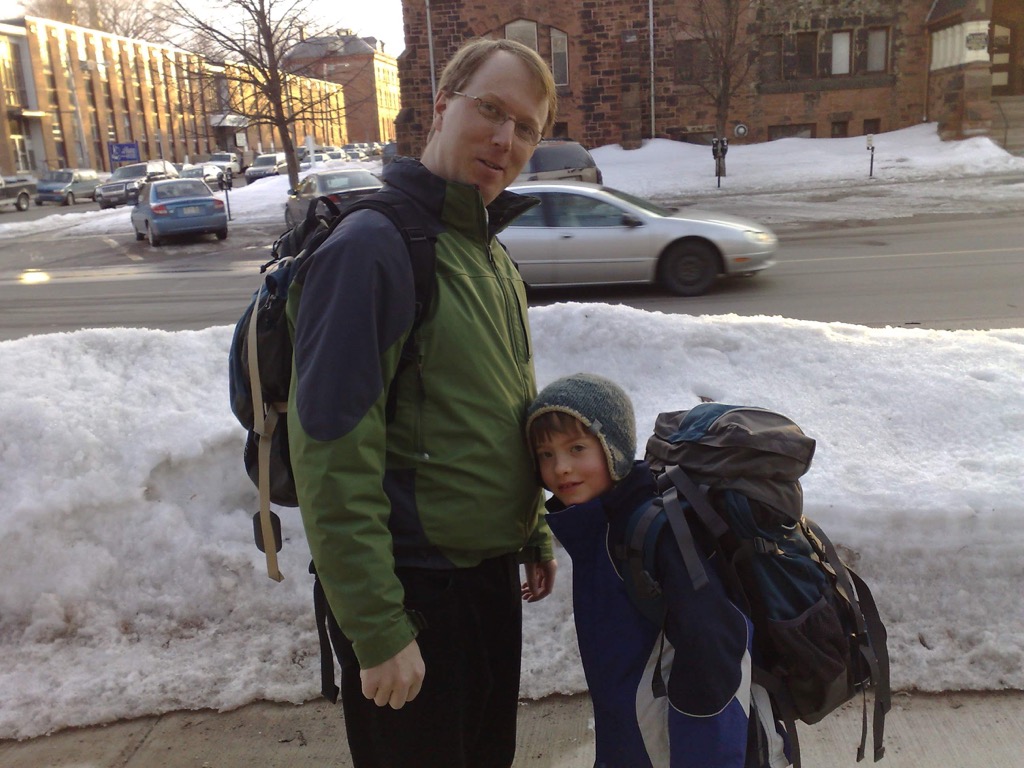
What you see on our backs is the sum total of the luggage we took; it was the apotheosis of my packing-light phase: I was traveling without a laptop (a feat never repeated, before or after) and with only a few clothes in my pack. Oliver was more well-resourced, especially if measured by luggage-to-body-weight ratio; but even he was traveling extremely light.
How I thought it was possible (and allowed) to head into a strange and remote place, across the ocean and far away, without Catherine to steady us is beyond me. Oliver had several “I am Oliver, and I’m traveling with me, and here’s his phone number” sheets stuck in his pack and his pockets, but that was the extent of our disaster-preparedness plan. Perhaps my derring do was inherited from my father who, at exactly the same age as I was in 2009, set off with me on a bus trip across America.
Because I didn’t have a laptop with me, my only connection to the Internet was on an early-model iPod Touch, so my blogging about the trip was light; one can only tap out so much on the tiny glass keyboard before one has to go to bed. As such events that in memory loom large and formative received only scant mention in the blog. This entry from March 17, 2009, for example, references Oliver locking himself in the hotel bathroom with only a sentence or two:
The highlight of the day came at the very end when Oliver somehow locked himself in the bathroom of our apartment. After 20 minutes of trying to talk him through unlocking the door and another 20 of the helpful front desk clerk trying various things, the Košice Fire Brigade was summoned in the person of a very kind man who eventually pried open the door enough to allow Oliver to pass the key out. Oliver emerged none the worse for it (well, he may never pee again).
Here, for posterity, is the full story.
Our destination of Košice, Slovakia was selected entirely on the basis of it being cheap to fly to from London, which is where we landed on the other side of the Atlantic. I was looking for big bang for small buck, and, thanks to the now-defunct airline SkyEurope, we were able to fly London to Košice for just 128 EUR. For both of us.
It was a grueling itinerary. We flew overnight on Air Canada from Halifax to London Heathrow, took the bus to Luton, and then, after a layover, flew Luton to Košice, arriving in the evening. SkyEurope was leasing planes from Bulgarian Airlines, and the tired condition of the 737 that we flew didn’t inspire confidence. But it got us there.
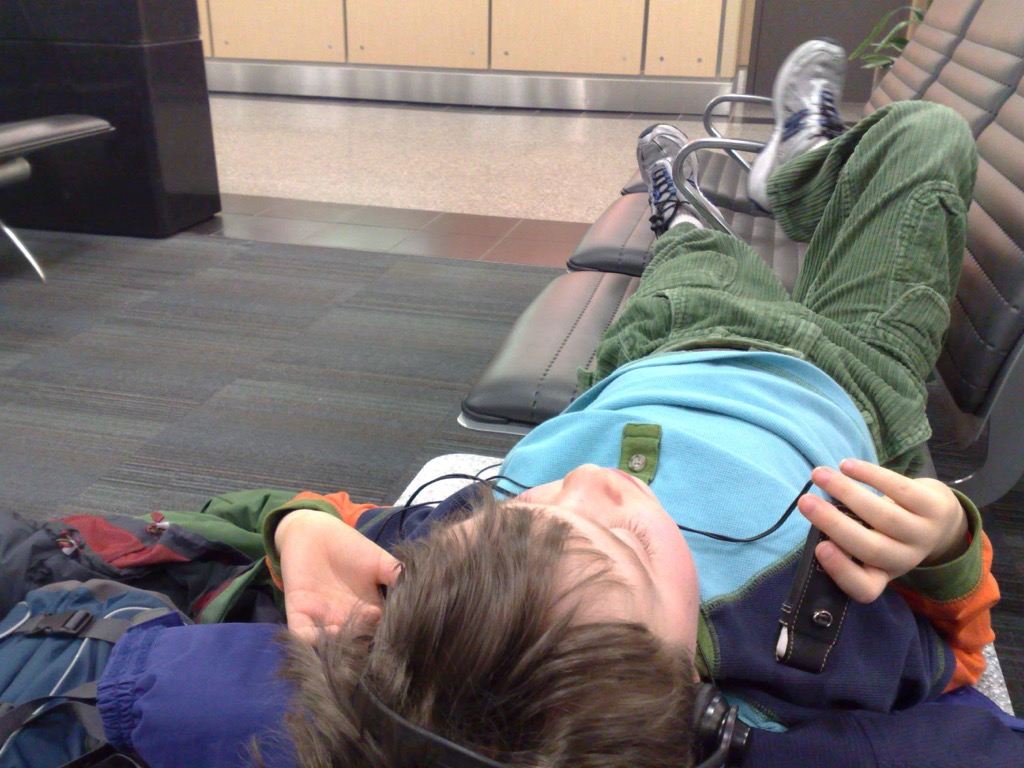
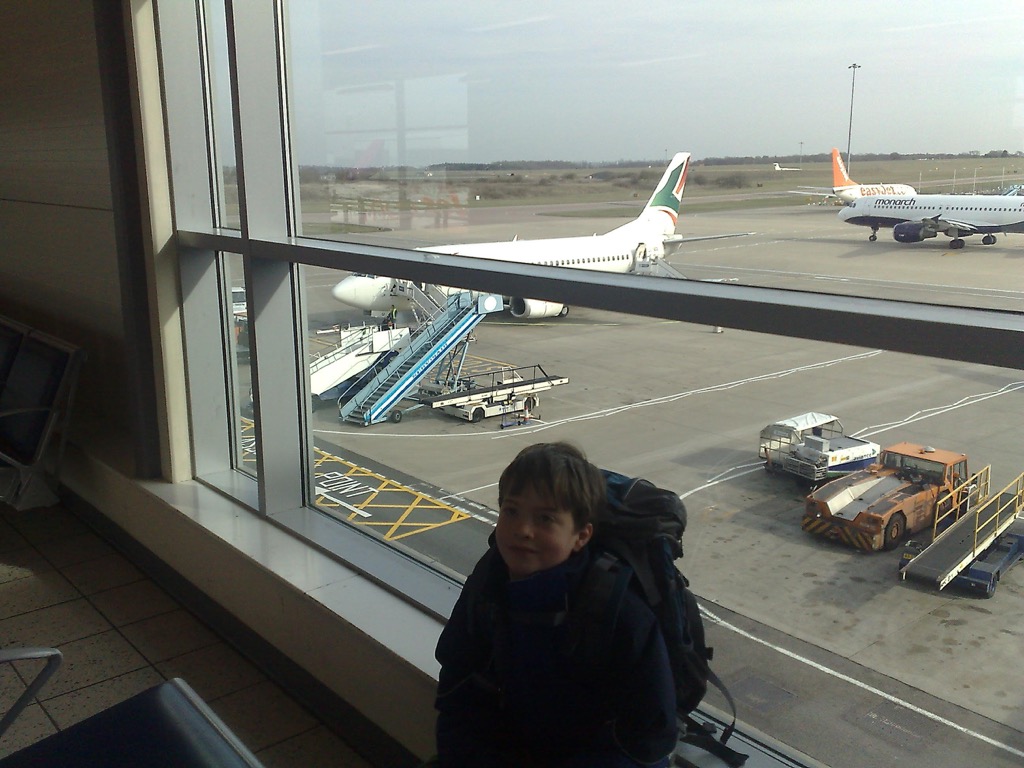
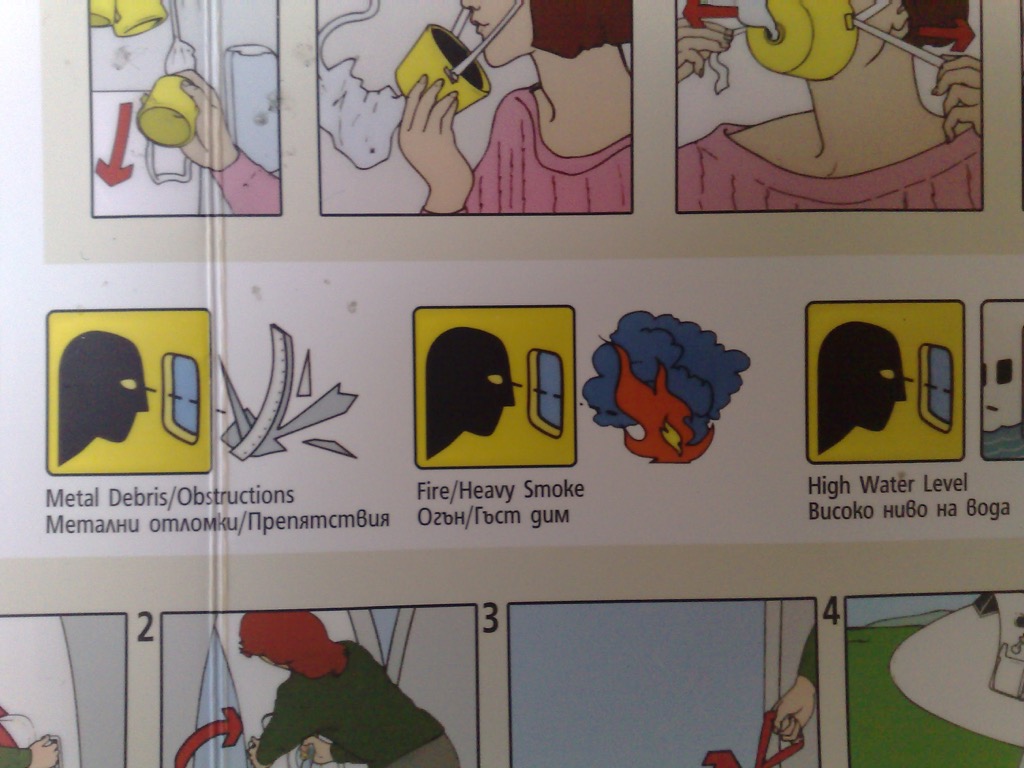
On arrival in Košice my grand plans to take the bus to our hotel fizzled in a puddle of jetlagged confusion and so we hopped in a cab and arrived at City Residence in short order (in fact I know exactly what time we arrived–8:00 p.m.–because I created a Plazes place for the hotel on arrival).
Both Oliver and I were zonked and so acting on the fringes of rationality. I was worried about having been out of touch with the home office for so long, so busied myself trying to get my iPod Touch hooked up to the hotel wifi so I could check my email for the first time in 24 hours.
In the midst of this maelstrom, Oliver asked me if it was okay to go to the washroom.
It’s important to understand at this point in the story that Oliver was, at this point in his life, only just becoming used to the idea of using public washrooms, and, along with the staff at Prince Street School, we’d been working hard to get him used to the idea of locking the bathroom stall at school.
And so it wasn’t unusual when Oliver asked me, before heading into the toilet, if he should lock the door.
“Of course you should,” I said, not particularly paying attention to any possible ramifications of what saying so might mean.
I eventually got myself online (the world had not ended, I was happy to find), and was making my way through my email backlog when I realized that I hadn’t heard from Oliver in quite a while.
“Oliver, are you there?” I shouted.
“Yes,” he replied. “I’m stuck.”
What had happened is this: the City Residence hotel was located in an old, well-renovated building with heavy wooden doors, inside and out, that locked with skeleton-like keys. Upon entering the toilet, Oliver had dutifully, per my instructions, turned the key in the lock to lock the door, gone about his ablutions, and then, when he went to leave the toilet, realized that he couldn’t unlock the door. The trick was that to unlock the door required slightly more mechanical “fiddle the lock to align the key” finesse than Oliver was capable of.
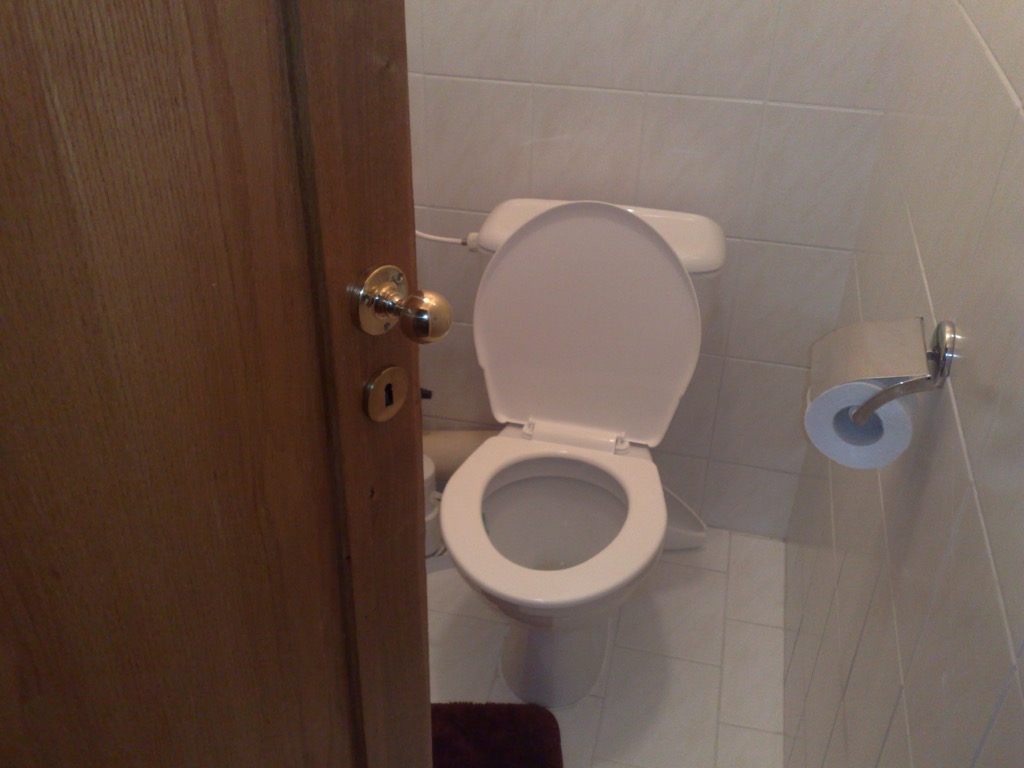
My first step in trying to rectify this was to talk him through the process of said-fiddling. To no avail (Oliver is not an oral learner, especially when locked in an Eastern European washroom).
My next step was to imagine that the front desk would likely have a spare key.
But our room didn’t have a phone, and we were on the top floor, so my only option was to leave Oliver in the locked washroom by himself and run down three flights of stairs to find the night manager.
My reaction to the enormity of that requirement was, upon further reflection, somewhat irrational: I called up Catherine on my mobile phone, apprised her of the situation, and put the phone beside the door so she could keep Oliver company during my absence. While on paper this made perfect sense, I failed to consider the trans-Atlantic panic-transference that I would cause (“Hi KD, everything’s okay, but Oliver’s locked in the bathroom and I need to leave, so could you keep him company for a while?”).
Fortunately, Catherine has a steady head, and, panic-transference or not, her disembodied presence proved helpful.
Meanwhile, I vaulted down to the lobby, found the night manager, and she quickly came back upstairs with me, carrying a medieval ring of every single key in the hotel’s collection.
None of which worked in the bathroom door in our room.
She opened up the other rooms on the floor (we were the only ones staying in the hotel, it seemed), and tried their bathroom door keys.
None of which worked in the bathroom door in our room.
We were running out of options. And Oliver, while maintaining Herculean-like cool in the face of this adversity, was starting to flag: he was flushing the toilet every minute or so to calm himself.
The night manager also was impressively cool, and she went off to call the fire brigade with hopes they could send someone over to… well, I’m not sure. Break down the door?
About 15 minutes, and a lot of toilet-flushing-calming, later, a friendly member of the Košice Fire Department arrived, tool box in hand, ready to see what he could do.
When it became apparent that breaking down the door was not an option, andthat explaining to Oliver, in Slovak, how to use the key was not an option, he motioned for me to help him haul on the bottom of the door to get it to the point where there was just enough of a gap opened up that Oliver could pass the key back through to us.
And it worked.
We unlocked the door, Oliver walked out, mostly unscathed.
We were all very, very happy. I took a picture of Oliver and his savior:
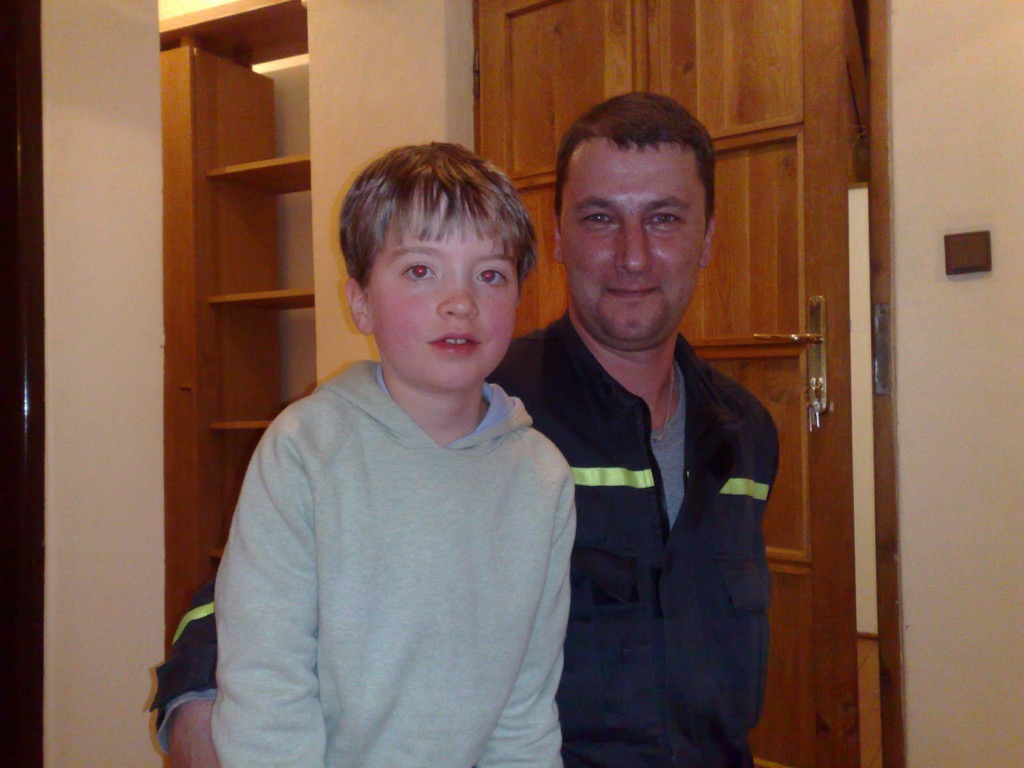
While I have no earthly concept of how long this took, the timestamp on that photo is 9:15 p.m., so I have to imagine it was at least an hour. We called Catherine back to assure her that everything was okay.
We bid the firefighter goodbye, with heartfelt thanks, thanked the night manager for working so diligently. And then we went out for pizza. It was late, but we were exhausted and very hungry.
We ended up at a Moroccan joint on the high street called Emir and wolfed down a pizza.
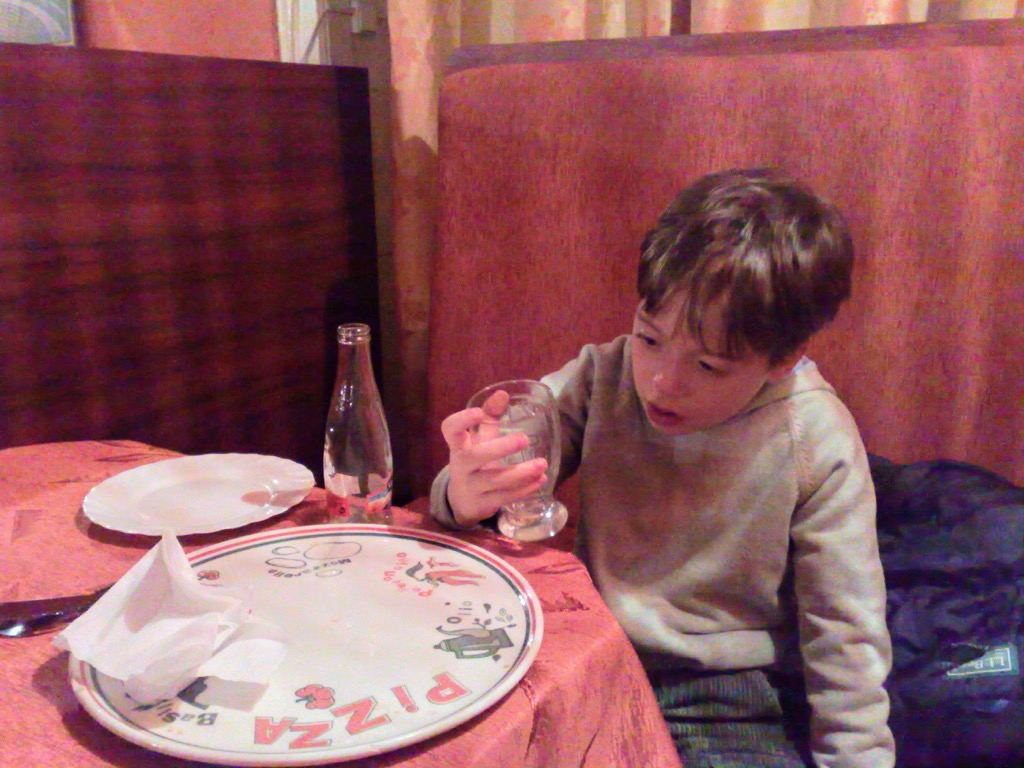
The rest of our visit to Košice, by comparison, was uneventful: we went to the ballet to see The Marriage of Figaro, visited the zoo, ate vegetarian goulash, saw the movie Marley and Me, and wandered around the city.
And then we headed west for Bratislava, Vienna, Nuremberg, Paris and London where we had many more adventures.
That trip a decade ago was a first of many that we took together over the following years, during the March school break: in 2010 it was Germany; 2011 and 2012 it was Florida to visit my parents; in 2013 we went to Japan; in 2014 we went to Toronto to fetch Ethan the Dog; in 2015 we took the year off; in 2016, 2017 and 2018 we spent the week in Halifax.
Along the way the young boy who looked like this:
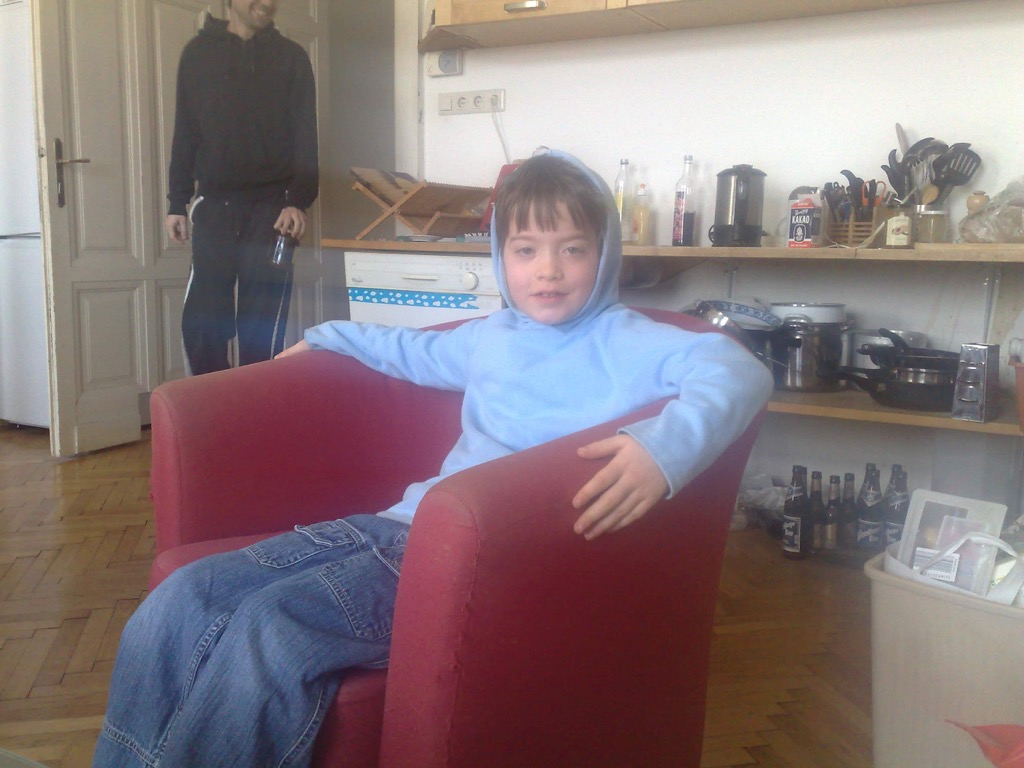
has turned into the young adult that looks like this:

I don’t know what possessed my father, in 1980, to think that heading off into yonder with his 14 year old son for a bus-vacation was a good idea, but that trip remains one of the highlights of my childhood, and of my relationship with my father. I am happy to have had that as a template for my own parenting, as the times that Oliver and I have spent in our own yonder have similarly been some of my happiest memories of being a parent.
In a land there’s a town, and in that town there’s a house
And in that house there’s a woman
And in that woman there’s a heart I love
I’m gonna take it with me when I go
If I could choose one musician above all others, it would be Tom Waits. And his Take It With Me is such a lovely song.
As children of the mother-democracy in the United Kingdom, we here in the Commonwealth can sometimes forget that our own practice of day to day parliamentary practice has evolved since we forged out on our own. Nowhere is this more evident than when one watches the televised proceedings of the House of Commons in London, a habit I’ve fallen into of late as the debate toward (or away from) Brexit has proved compelling.
One of the more noticeable differences between the London parliament and the Charlottetown one is that in London they have division lobbies, separated physical areas, on either side of the chamber, to which members retire to vote yes or no on a given motion or amendment.
Here’s how the process is laid out in the 2013 Divisions in the House of Commons: House of Commons Background Paper:
When a motion is put to the vote, the Speaker ‘puts the question’, by saying:
The Question is, that … [for example, the Bill be read a second time]. As many as are of that opinion say Aye”, (there then follows a chorus of shouted Ayes), “of the contrary No” (a similar shout of No)…..
At this point, if there is no dissent, the motion will be carried, and the Speaker will say “I think the Ayes have it”. There is then no need for a formal division to take place.
However, if Members do not agree, the Speaker calls a division. S/he announces “Clear the Lobbies”. The division bells ring throughout the House of Commons estate, the Annunciators display “Division”, and the police direct all non-members to leave the vicinity of the Members’ Lobby; they also walk through the public rooms of the House shouting “Division”. … The Speaker has the discretion to ask each side to stand in their places in the Chamber, if s/he believes that a division is unnecessary.
Before each vote takes place, those voting both ‘aye’ and ‘no’ must appoint two Members to act as tellers. Their job is to report the result of the vote to the House. They themselves will be counted as having voted either ‘aye’ or ‘no’: reports on some websites will, for instance, report “189 + 2 tell” as having voted in a certain way.
That part about “the division bells ring throughout the House of Commons estate” caught my eye. Members have 8 minutes after the division bells start to ring to get to the appropriate lobby; 8 minutes, if you’re walking at a fast clip, will get you a fair distance, and it’s for this reason that the division bells ring not only in the House of Commons itself, but also in nearby pubs and restaurants.
For example, according to OpenStreetMap, the walk from The Cinnamon Club to the House of Commons takes exactly 8 minutes. And as there are so-called “external division bells” in The Cinnamon Club, this means that a member could be lunching there and make it to the division lobby in time to cast a vote.
The BBC News website has a 2017 story that provides a good introduction to the practice.
While we don’t have division lobbies here in the Legislative Assembly of PEI–members vote in the chamber–we do have division bells, something pointed out by MLA Wilbur MacDonald in 2004 when he rose, on a point of order, to mention a new electronic set:
7:00 P.M. Rising on a Point of Order, Wilbur MacDonald (Belfast-Pownal Bay) requested a demonstration of the Legislative Assembly’s new electronic division bell and requested that it be rung for five minutes prior to the House sitting on a sessional sitting day.
Here’s how the process of “putting a question to the house” works here in Prince Edward Island, according to the rules:
18. Putting a question to the House
Is the House ready for a question?
The question is as follows: …..
All those in favour of the motion will please say yea.
All opposed will please say nay.
In my opinion, the motion is carried (or lost).If any member requests a recorded division, sometimes called a standing vote, the Speaker says:
Sergeant-at-Arms, ring the bells.
After no more than 5 minutes, when the members are in, the Speaker says:
All those opposed to the motion please rise.
(and after the names have been recorded by the Clerk)
All those in favour of the motion please rise.
I declare the motion carried (or lost).
We don’t have external division bells here in Charlottetown, so members must be within earshot of the chamber to hear the bells ringing. Five minutes in downtown Charlottetown will get you pretty far, though: according to OpenRouteService’s isochrones, the distance you can travel in 5 minutes from the Coles Building on foot is reflected in red on this map:
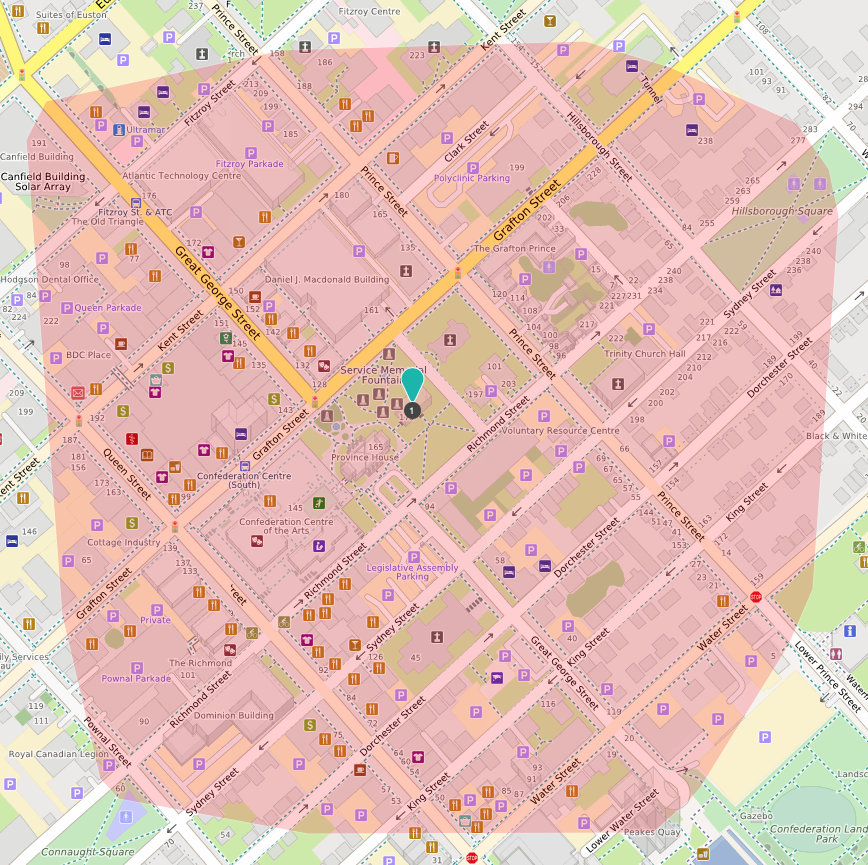
So, in theory, a member could be at Cedar’s when a vote is called and, assuming quick reflexes and a brisk pace, be in their seat for the vote.
Over the quarter century we’ve lived in Charlottetown, I’ve never particularly thought of The Bookmark, our local independent bookstore, as a place to order books. For some inexplicable reason I thought it was more trouble than it was worth for them, and so I simply fell into the habit of ordering books online.
Recently, though, I noticed a big search box at the top of the store’s website labelled Search for anything, and that seemed like clear evidence that they wanted me to order books from them and, indeed, that they could get anything on order.

And so I’ve started to order my books from The Bookmark instead of from Amazon. The store’s prices are often a dollar or two more than Amazon’s, and it can take a little longer for books to arrive (but not much longer), but you don’t pay shipping if you pick up at the store, and you don’t have to pay until the book arrives.
What’s more, I help to ensure the longevity of my local independent bookstore by buying locally. So as part of the deal, I get a local place to browse for books that’s open seven days a week, has a thoughtful and broad approach to stocking its shelves, and that sells fountain pens and ink to boot. Here’s what The Bookmark itself says:
We believe in a local economy – we believe that spending money is a political act, every dollar we spend casts a ballot for the kind of world we want to live in. There is no right or wrong answer, but if you don’t shop locally, if you don’t support the local economy, in the real world, there won’t be one left when you step outside. At Bookmark, we are strong supporters of the local literary community. We also take seriously spending our dollars locally for marketing services, accounting, legal and other business services.
By way of encouraging others (and myself) to look to The Bookmark when our Amazon muscle memory runs so strong, using Jon Udell’s excellent LibraryLookup as a starting point, I’ve created a handy “look this up at The Bookmark” bookmarklet (ha! was there ever a bookmarklet better named!).
The idea is this: you’re readying a blog post, say, and it has a link to a book at Amazon.com. You visit the Amazon book page, click the bookmarklet and, blamo, you see the same book on The Bookmark’s site.
The Bookmark[let]
To install the bookmark, just drag the link above to your browser’s bookmarks toolbar.
Here’s the bookmarklet in action.
From the Amazon.ca page for If Cats Disappeared from The World:
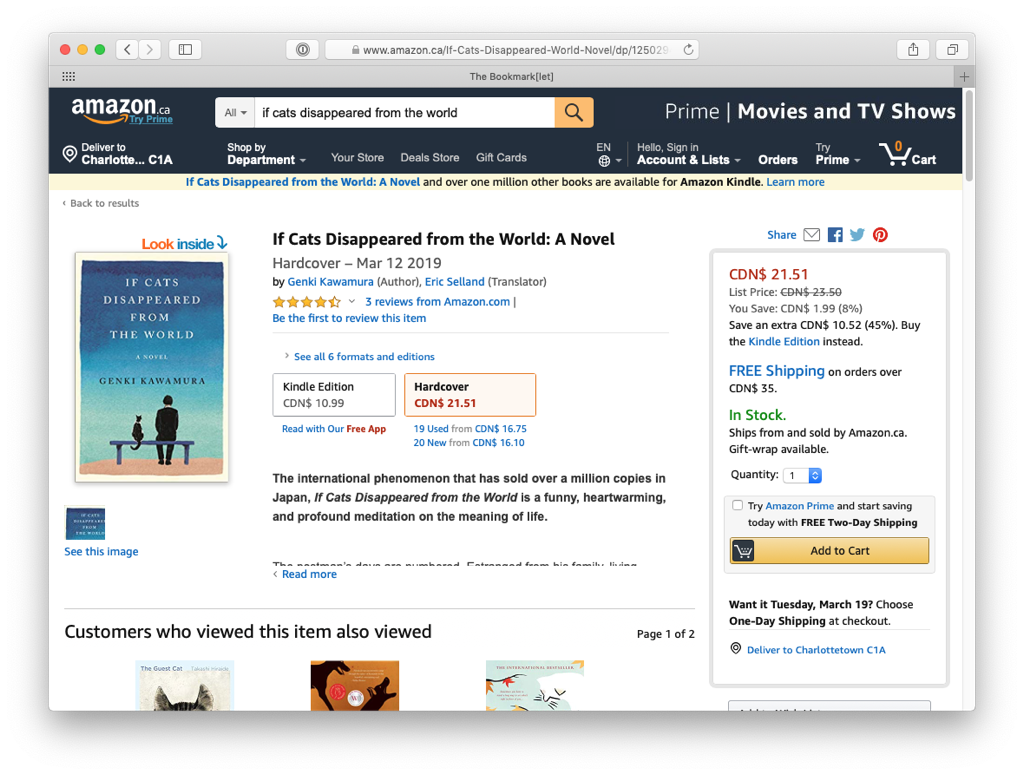
I click the bookmarklet on my browser’s toolbar and a new browser window pops up with the ISBN for the book fed to The Bookmark’s search tool:
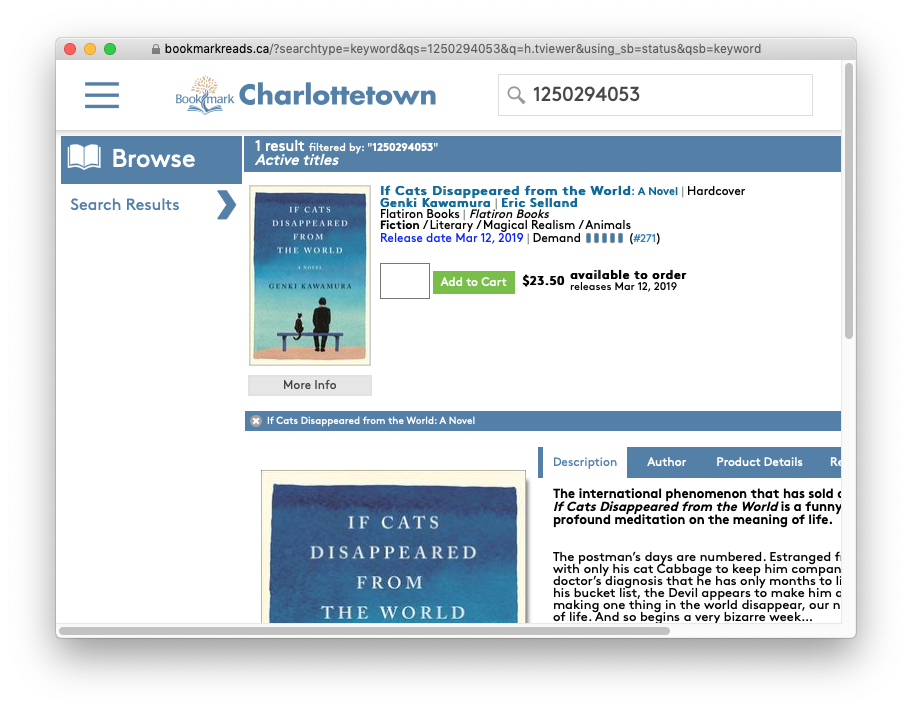
From there it’s an easy matter to order the book from The Bookmarklet (and it’s worthwhile to note that Amazon.ca’s shipping was $5.73 while The Bookmark didn’t charge any shipping at all, so, in fact, it was less expensive to order locally).
Needless to say, this bookmarklet has no affiliation with Amazon nor with The Bookmark; it’s simply a technical intervention, created by me, to encourage people to shop at my local bookstore.
When is a “student strike” not a strike? When the school’s morning announcements invite students to participate.
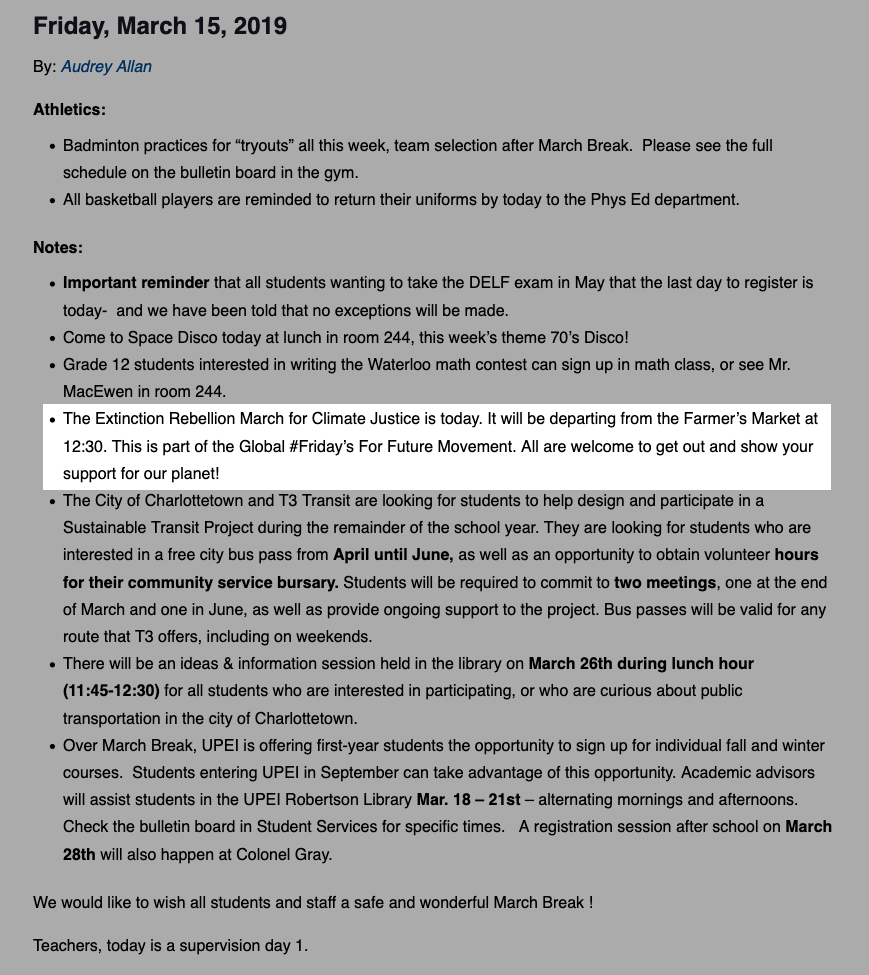
This cover of Dodie’s Monster by Pomplamoose ft. Dodie is brilliant.
Pomplamoose is on fire these days and Pomplamoose ft. X, more often than not, results in a version of X that’s better than X alone.

 I am
I am